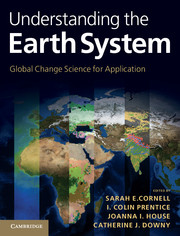Book contents
- Frontmatter
- Contents
- Editors
- Scientific editorial team members
- Contributing authors
- Foreword
- Preface
- Acknowledgements
- Units
- 1 Earth system science and society
- 2 Fundamentals of climate change science
- 3 How has climate responded to natural perturbations?
- 4 The Earth system feedbacks that matter for contemporary climate
- 5 Earth system models
- 6 Climate change impacts and adaptation
- 7 The role of the land biosphere in climate change mitigation
- 8 Society’s responses and knowledge gaps
- Acronyms
- Glossary of terms
- Index
- References
6 - Climate change impacts and adaptation
An Earth system view
Published online by Cambridge University Press: 05 November 2012
- Frontmatter
- Contents
- Editors
- Scientific editorial team members
- Contributing authors
- Foreword
- Preface
- Acknowledgements
- Units
- 1 Earth system science and society
- 2 Fundamentals of climate change science
- 3 How has climate responded to natural perturbations?
- 4 The Earth system feedbacks that matter for contemporary climate
- 5 Earth system models
- 6 Climate change impacts and adaptation
- 7 The role of the land biosphere in climate change mitigation
- 8 Society’s responses and knowledge gaps
- Acronyms
- Glossary of terms
- Index
- References
Summary
In this chapter, we address the biophysical impacts of climate change, and the consequent impacts on socio-economic systems. Modelling the impacts associated with future climate change provides important information for society’s mitigation and adaptation responses. It also presents significant challenges for Earth system science. We discuss the ways in which uncertainty in impact modelling arises and how it can be managed.
Introduction
Key concepts
Changes in climate, including those arising as a consequence of anthropogenic perturbations of the climate system, can result in a wide variety of impacts on Earth’s ecosystems and the human activities that depend on them. There are two good practical reasons why it is important to understand the processes involved and assess the possible magnitudes of impacts.
First, an assessment of the extent to which continued anthropogenic climate change could inflict damage is needed in order that well-informed decisions can be made about the reduction of human influences on climate. Our understanding of Earth system behaviour alerts us to the fact that action to mitigate climate change through reductions in greenhouse-gas emissions is not without consequences; so decisions to pursue mitigation options need to be weighed up on the basis of reliable estimates of the costs, risks and benefits of different courses of action.
Secondly, the increase in atmospheric greenhouse-gas concentrations since the Industrial Revolution means that further climate change is inevitable even if greenhouse-gas emissions were to be reduced soon ( Figure 6.1 ). It is therefore necessary for society to adapt to unavoidable changes. Since adaptation action is also not without consequences, it is important that adaptive action addresses credible risks , and represents an efficient allocation of resources.
- Type
- Chapter
- Information
- Understanding the Earth SystemGlobal Change Science for Application, pp. 160 - 201Publisher: Cambridge University PressPrint publication year: 2012
References
- 7
- Cited by

